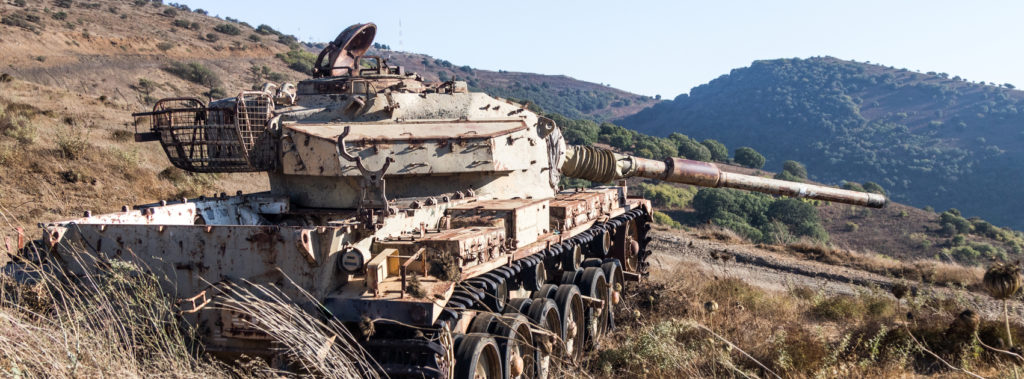In 1973, Israel found itself once again at odds with a number of formidable foes in the Yom Kippur War.
Egypt, Syria, and the League of Arab Nations joined forces. They reclaimed territory ceded to Israel following the first Arab-Israeli conflict of 1948. They also amassed armies large enough to destroy Israel once and for all.
Even with all odds against it, Israel—with the support of the United States—was able to, once again, hold its own against the enemy. As a result, the Israelis were able to develop new military technology that the world has adopted. This new Israeli military technology greatly helps protect soldiers, especially in the desert combat.
Operation Nickel Grass
Shortly before the Yom Kippur War broke out, the Egyptian army mobilized and conducted maneuvers putting Israel on high alert. Lack of ammunition and supplies for self-defense was a major concern of Israel at the time.
The United States rushed to Israel’s aide and delivered vital supplies—over 20,000 tons of tanks and other equipment were rushed from the United States across the Atlantic overnight.
This delivery prepared Israel before the Egyptian and Syrian armies launched their attacks.
The procedure, known as Operation Nickel Grass, took place on October 10th—four days after Egypt’s surprise attack.
The fighting lasted 19 days, then Israel and Egypt signed a ceasefire agreement. The Syrians were defeated and gave up even more of the Golan Heights to Israel.
The victory came at a high cost of resources and human life for Israel. The supplies provided by the United States arrived at just the right time.
Following the war, the U.S and Israel studied the battlefield. As a result, they developed several life-saving technologies.
Hydraulic Fluid in Tanks
At one time, American-built tanks used a type of hydraulic liquid known as “cherry juice.” It was petroleum-based and highly flammable. In the hot desert environment, tanks would overheat and catch fire even before they managed to reach the enemy.
The flammable liquid made them vulnerable to enemy missiles and mortars. They could land near the tanks and cause damage. The proximity of the blast caused the hydraulic fluid in the tanks to catch fire.
Since 1973, the United States Army, as well as militaries worldwide, have replaced the highly flammable hydraulic fluid with a synthetic lubricant called FRH (Flame Resistant Hydraulic).
Reactive Tank Armor
West German scientists and the Israel Defense Forces (IDF) developed a unique armor, known as ERA (Explosive Repellant Armor), in response to kinetic energy penetrators. The KEPs are special armor-piercing spears that are launched out of a cannon so fast, they can pierce through the armor of a standard tank.
This special armor helped save countless lives in the Israeli-Yemeni war of 1982, and better protected Americans during the first Persian Gulf War of 1991.
Active Protective System
Tanks may be the master of ground combat, but they are vulnerable to attacks from above.
During the Yom Kippur War, the Syrians and Egyptians had access to a state-of-the-art Russian anti-tank technology. This technology was known as the AT-3 Sagger (known in Russia as Malyutka). It was responsible for destroying over 800 Israeli armored vehicles—including many M60 Patton tanks provided by the United States.
The M60 Patton tanks were among the best tanks in the world at the time. They were even used decades later by the United States in the Persian Gulf War of 1991.
The whole world watched as the well-equipped Israelis met their match. Outnumbered and outgunned in the heat of battle, there was no time to develop new Israeli military technology. As a result, the Israelis had to get creative with their maneuvers to survive.
The Israelis knew that the Malyutka missiles were operated from afar by a soldier who could guide the weapon with a joystick. One of the ways Israelis evaded enemy fire was to shoot a tank mortar directly ahead of themselves to create a cloud of dust, then move the tank rapidly back and forth to make themselves a nearly impossible target to see or hit. The tanks would also fire from the smokescreen, which destroyed or scared off the enemy.
NATO and other militaries around the world swiftly adopted Israel's tactics in dealing with the Sagger Missiles. Meanwhile, the ever-self-improving Israel began developing new Israeli military technology to deal with the threat that so many had sacrificed to defeat.
The Soviets developed the first Active Protective System in the late 70’s. It was in response to suffering heavy casualties during the First Chechen War. The world was quick to follow in developing similar technology. In recent years Israel has developed the best.
The United States has recently purchased the latest Israeli tank defense technology, known as “Trophy.” It equips its own tanks stationed in Europe, whose presence will reassure American allies in the face of Russia’s recent activity.
Uphold the Life of Democracy
“Behold, God is my helper;
the Lord is with those who uphold my life.”
—Psalm 54:4
The partnership between Israel and the United States has sustained the lives of countless men and women who are fighting for our freedom. As our militaries continue to develop new tactics and technology, My Olive Tree is partnering with the Israeli Defense Forces to support the troops in other ways. We are no experts in war, but as Believers, we know a thing or two about giving.
Our mission is to give the Israeli soldiers something special to come home to. We are restoring the desert in Israel by planting olive trees in order to create a beautiful garden as described in the Bible.
We invite you to help uphold the IDF as they have helped uphold our armed forces. Find out more about how your contribution to our cause will help Israel flourish and the desert bloom!
